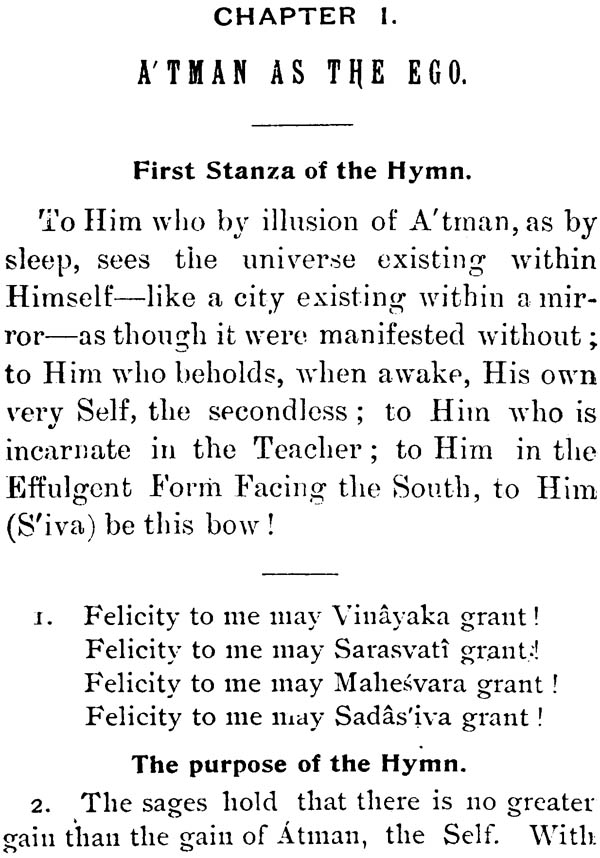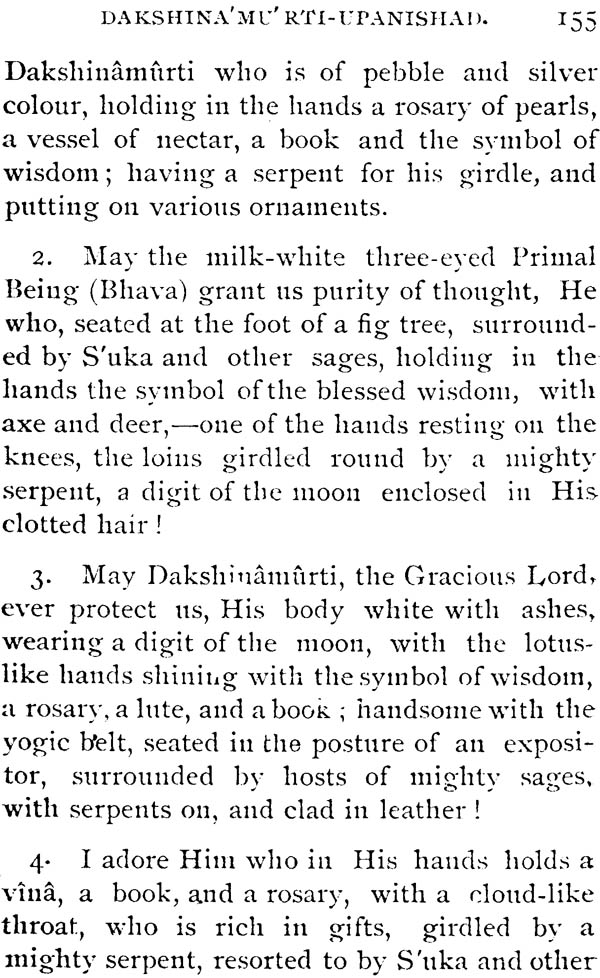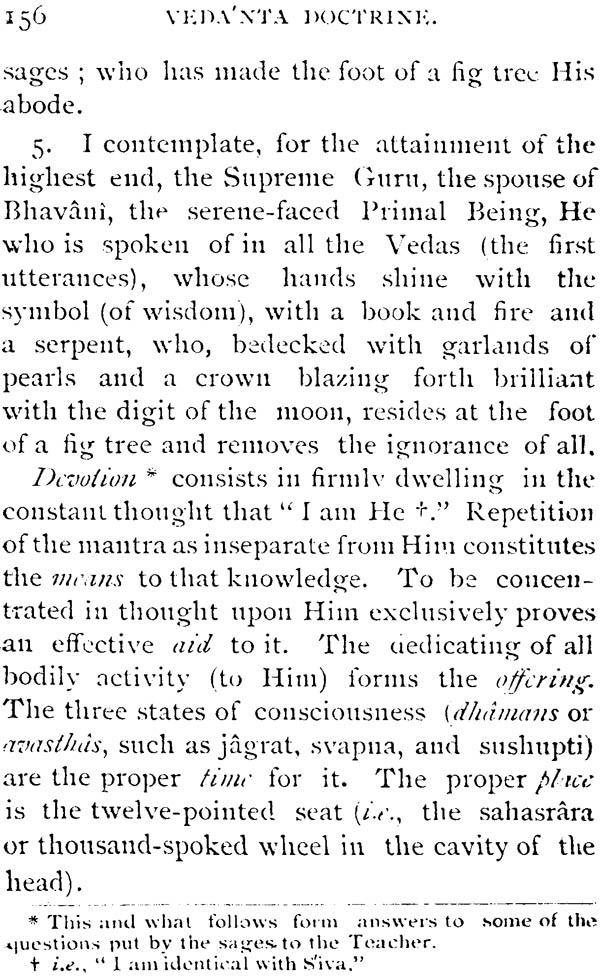
The Vedanta Doctrine of Sri Sankaracarya
Book Specification
| Item Code: | IHL295 |
| Author: | A. Mahadeva Sastri |
| Publisher: | Sri Satguru Publications |
| Language: | English |
| Edition: | 2008 |
| ISBN: | 8170300290 |
| Pages: | 245 |
| Cover: | Hardcover |
| Other Details | 8.9 Inch X 5.7 Inch |
| Weight | 400 gm |
Book Description
The present book contains the English translation with explanatory notes on the following works.
1. Sri Sankaracharya’s dakshinamurti-Stotra an ode to the Divine Self with Sri Suresvaracharya commentary Manasollasa.
2. Sri Suresvaracharya’s Pranava vartika treating of the contemplation of the supreme Atman by means of Pranava.
3. Dakshinamurti Upanisads.
Sri Sankaracharya’s immortal Hymn and the two works of Suresvaracharya herein comprised epitomize the whole Vedanta Doctrine as expounded by the two authors in their commentaries on the Upanisads and from a good introduction to a study of the subject.
This volume comprises the following works literally translated into English with explanatory comments:
i. Sri Sankaracharya’s Dakshinamurti-Stotra an ode to the divine self with Sri Suresvaracharya’s exposition named Manasollasa Brilliant play of thought.
ii. Sri Suresvaracharya’s Pranava-Vartika treating of the contemplation of the supreme Atman by means of Pranava.
iii. Dakshinamurti – Upanishad.
Sankaracharya’s immortal Hymn and the two works of Suresvaracharya herein comprised epitomize the whole Vedanta Doctrine as expounded by the two authors in their commentaries on the Upanishads and form a good introduction of the fundamental truths of the Vedanta the well known Hymn of Sankaracharya forms a suitable text upon which the student many meditate and thereby construct the whole doctrine for himself. The reader will also be struck with the catholicity of the teaching which is not addressed to any particular class of people nore contains any reference to distinctions of caste and religious order while concisely stating the process by which the oneness of self and the unreality of all else is established Manasollasa is more original and telling than any of the later manuals which state the doctrine as derived from the expositions of the two eminent leaders of the Vedanta school of thought.
Very little need be said regarding the high position which Sankaracharya holds among the teachers of the Vedic Religion. Of Suresvaracharya however ordinary students of Vedanta know less than they ought to simply because his writings have long remained inaccessible to all but the very select few who entered the fourth order of sannyasa and were intellectually qualified to study the highly erudite exposition of philosophy and metaphysics. Suffice it to say that according to all received accounts the great aim of Sankaracharya’s missionary peregrinations was to secure the eminent mimamsaka’s allegiance to his won system of Vedanta. The nature of the work to which this disciple is said to have been detailed by the teacher and the masterly fashion in which he has done it the work namely of elucidating systematizing supplementing and even improving upon the great master’s teachings more than justifies the honorable position which tradition has unanimously accorded to him. He is known as the Vartika kara author of elucidative comments on the teachings of Sankaracharya who is known as the Bhasyakara author of original commentaries. Vartika is defined as follows :
Uktanuktaduruktarthavyaktakari tu vartikam.
A vartika is that which clearly explains what has been said what has been left unsaid and what has been ill said, five works of the kind are attributed to Suresvaracharya all of them having been recently published in India :
(1) Manasollasa (Mysore)
(2) Pranava-Vartika (Mysore)
(3) Naishkarmya-siddhi a manual of Advaita doctrine (Bombay Sanskrit Series).
(4) An exposition of Sankaracharya’s commentary on the Taittiriya Upanishad (Poona A’nandasrama series).
(5) An exposition of Sankaracharya’s commentary on the Brihadaranyaka Upanishad (Poona Anandasrama Series).
Suresvaracharya’s exposition of the Vedanta doctrine is often so very original and is throughout marked with such thoroughness precision and clearness that it forms a very valuable supplement to the teachings of the Upanishads and its authority on all knotty points is acknowledged with due reverence and submission by all the Atavitic writers of later days.
As an effective aid to a right understanding of the truths taught in the Vedanta Sankaracharya’s Hymn as well as Sruti inculcates highest devotion to the divine being as the guru of Gurus and an equal devotion to one’s own immediate Guru who should be regarded as an incarnation of that Guru of Gurus. The Dakshinamurti-Upanishad shows in what form Siva the Guru of Gurus should be imaged and devoutly worshipped in the heart by the neophyte who is about to engage in a contemplation of the truths taught in the hymn. The style of the Upanishad is in perfect keeping with the character of the minor Upanishads described in my introduction to the minor Upanishads Vol. I.
As Suresvaracharya’s Manasollasa refers to various philosophical systems of his day. I have thought it necessary to add an introduction to it treating briefly of the origin methods and fundamental tenets of the several systems referred to so that the reader may have a comprehensive view of the whole range of Indian philosophy at whose summit towering high above all stands Vedanta the pinnacle of Aryan thought.
| I. Sankaracharya’s Dakshinamurti Stotra and Suresvaracharya’s Manasollasa with comments | |
| | |
| Para. 1. Love of god and Guru the key note of all revealed religious - 2. Man’s highest end – 3 Man’s evolution as an individual – 4 Necessity for Revelation – 5 Devotion to Guru Necessary – 6.7. Karmakanda and its lessons - 8. Upansana Kanda and its lessons – 9. Jnana Kanda – 10.11. Devotion and knowledge – 12 Origin and growth of Philosophy – 13. Rise of materialism – 14. Intellectual speculation orthodox and heterodox – 15 Orthodox methods of intellectual speculation – 16. The Tarkika’s tenants – 17. The Sankhya Doctrine – 18. Buddhistic Doctrine – 19. Doctrine of the Arhata – 20. Reaction against pure intellectual speculation – 21. Right method of interpreting the Veda – 22. The Mimamsa Doctrine – 23. The Vedanta and its several schools – 24.25. The Advaita Doctrine – 26. Absolute unity of the self and Brahman taught in the Upanishads – 27. Distinction between Jiva and Isvara is due to Maya -28. Jiva is one with Isvara -29. Atman the material cause of the Universe – 30. Atman the one Existence – 31. Maya and Vidya – 32. May defined – 33. Yoga necessary for self realization – 34.35. Substantial agreement among philosophers as to the essential nature of Atman and the unreality of the universe – 36. Conclusion |

















